wheel size CHRYSLER PACIFICA 2019 Vehicle Warranty
[x] Cancel search | Manufacturer: CHRYSLER, Model Year: 2019, Model line: PACIFICA, Model: CHRYSLER PACIFICA 2019Pages: 270, PDF Size: 2.52 MB
Page 70 of 270
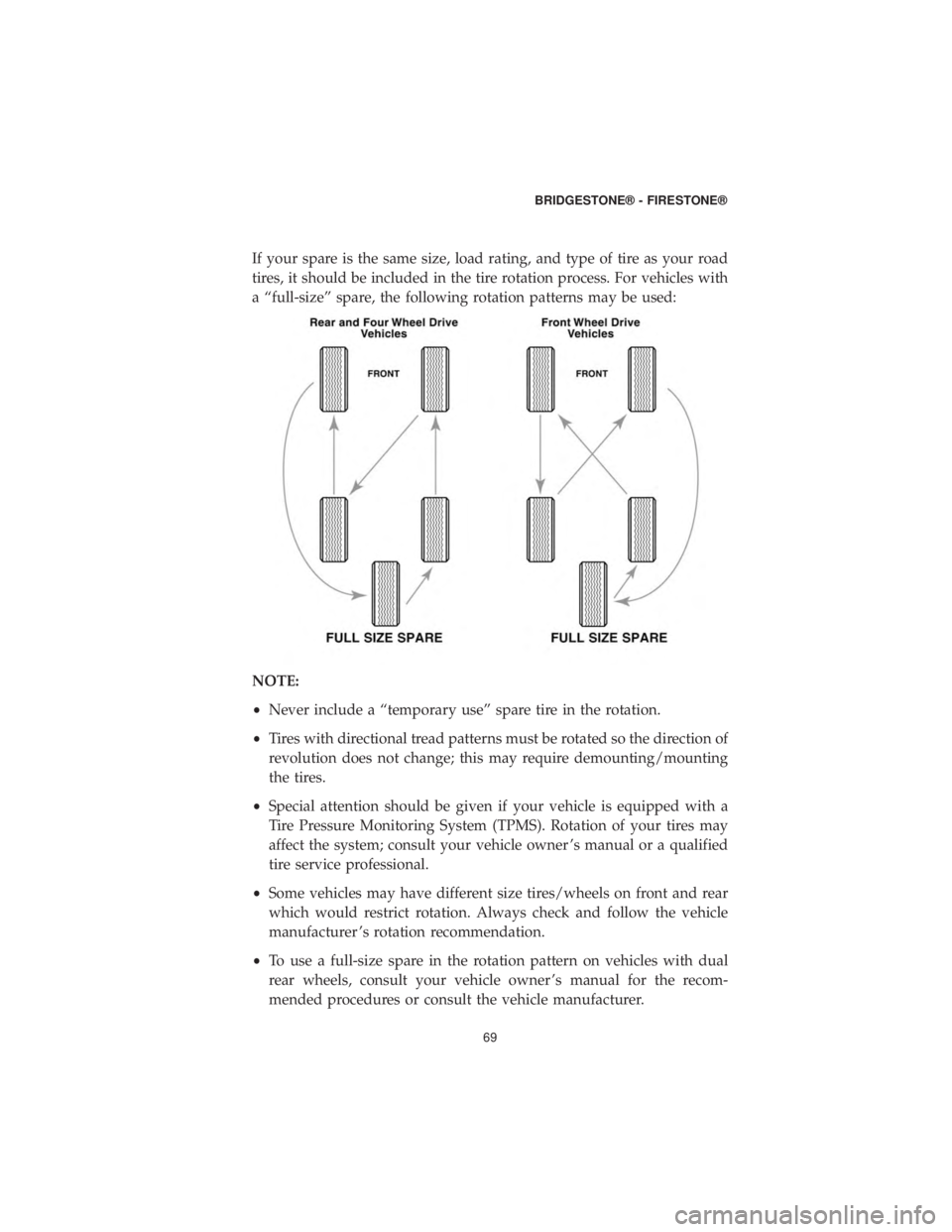
If your spare is the same size, load rating, and type of tire as your road
tires, it should be included in the tire rotation process. For vehicles with
a “full-size” spare, the following rotation patterns may be used:
NOTE:
•Never include a “temporary use” spare tire in the rotation.
• Tires with directional tread patterns must be rotated so the direction of
revolution does not change; this may require demounting/mounting
the tires.
• Special attention should be given if your vehicle is equipped with a
Tire Pressure Monitoring System (TPMS). Rotation of your tires may
affect the system; consult your vehicle owner ’s manual or a qualified
tire service professional.
• Some vehicles may have different size tires/wheels on front and rear
which would restrict rotation. Always check and follow the vehicle
manufacturer ’s rotation recommendation.
• To use a full-size spare in the rotation pattern on vehicles with dual
rear wheels, consult your vehicle owner ’s manual for the recom-
mended procedures or consult the vehicle manufacturer.
BRIDGESTONE® - FIRESTONE®
69
Page 71 of 270
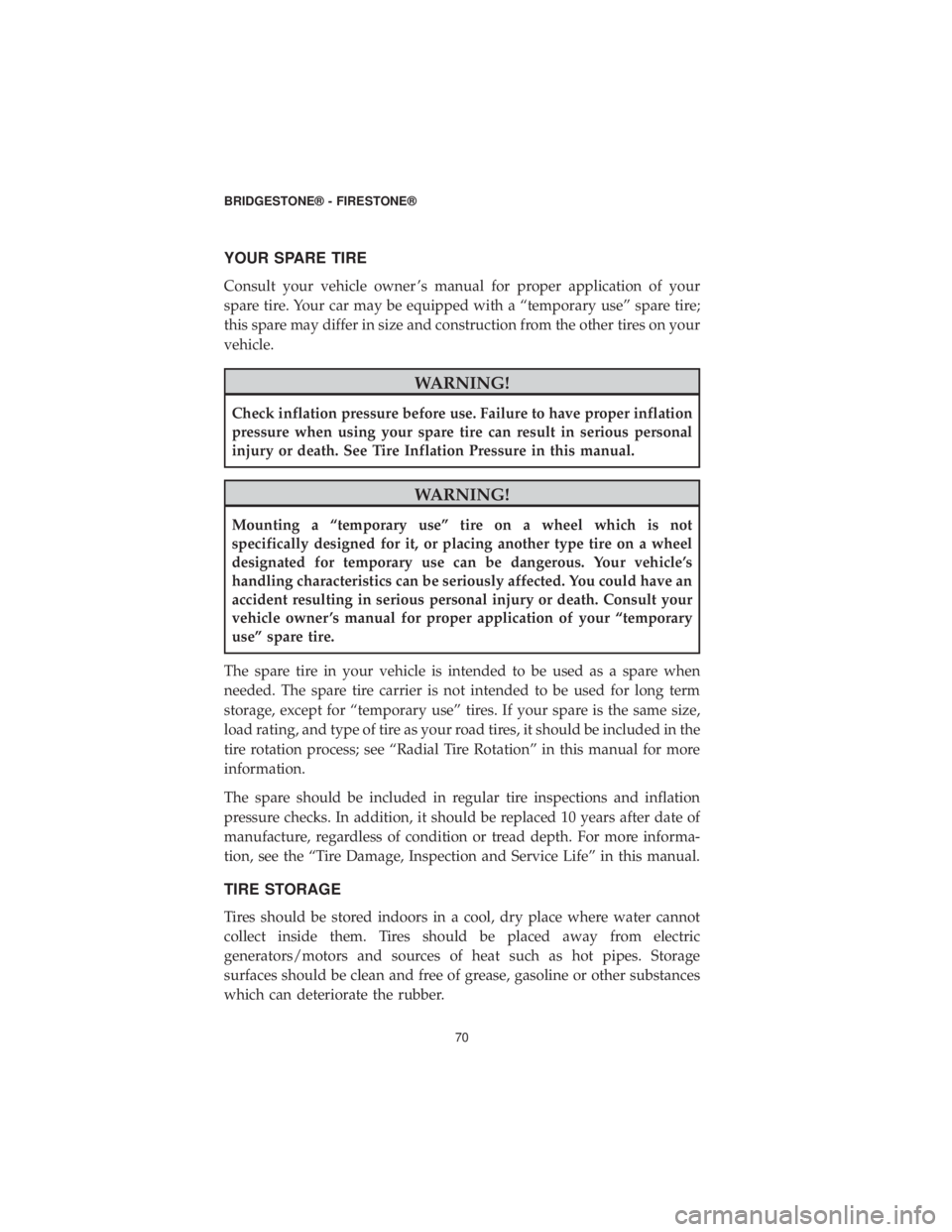
YOUR SPARE TIRE
Consult your vehicle owner ’s manual for proper application of your
spare tire. Your car may be equipped with a “temporary use” spare tire;
this spare may differ in size and construction from the other tires on your
vehicle.
WARNING!
Check inflation pressure before use. Failure to have proper inflation
pressure when using your spare tire can result in serious personal
injury or death. See Tire Inflation Pressure in this manual.
WARNING!
Mounting a “temporary use” tire on a wheel which is not
specifically designed for it, or placing another type tire on a wheel
designated for temporary use can be dangerous. Your vehicle’s
handling characteristics can be seriously affected. You could have an
accident resulting in serious personal injury or death. Consult your
vehicle owner ’s manual for proper application of your “temporary
use” spare tire.
The spare tire in your vehicle is intended to be used as a spare when
needed. The spare tire carrier is not intended to be used for long term
storage, except for “temporary use” tires. If your spare is the same size,
load rating, and type of tire as your road tires, it should be included in the
tire rotation process; see “Radial Tire Rotation” in this manual for more
information.
The spare should be included in regular tire inspections and inflation
pressure checks. In addition, it should be replaced 10 years after date of
manufacture, regardless of condition or tread depth. For more informa-
tion, see the “Tire Damage, Inspection and Service Life” in this manual.
TIRE STORAGE
Tires should be stored indoors in a cool, dry place where water cannot
collect inside them. Tires should be placed away from electric
generators/motors and sources of heat such as hot pipes. Storage
surfaces should be clean and free of grease, gasoline or other substances
which can deteriorate the rubber.
BRIDGESTONE® - FIRESTONE®
70
Page 79 of 270
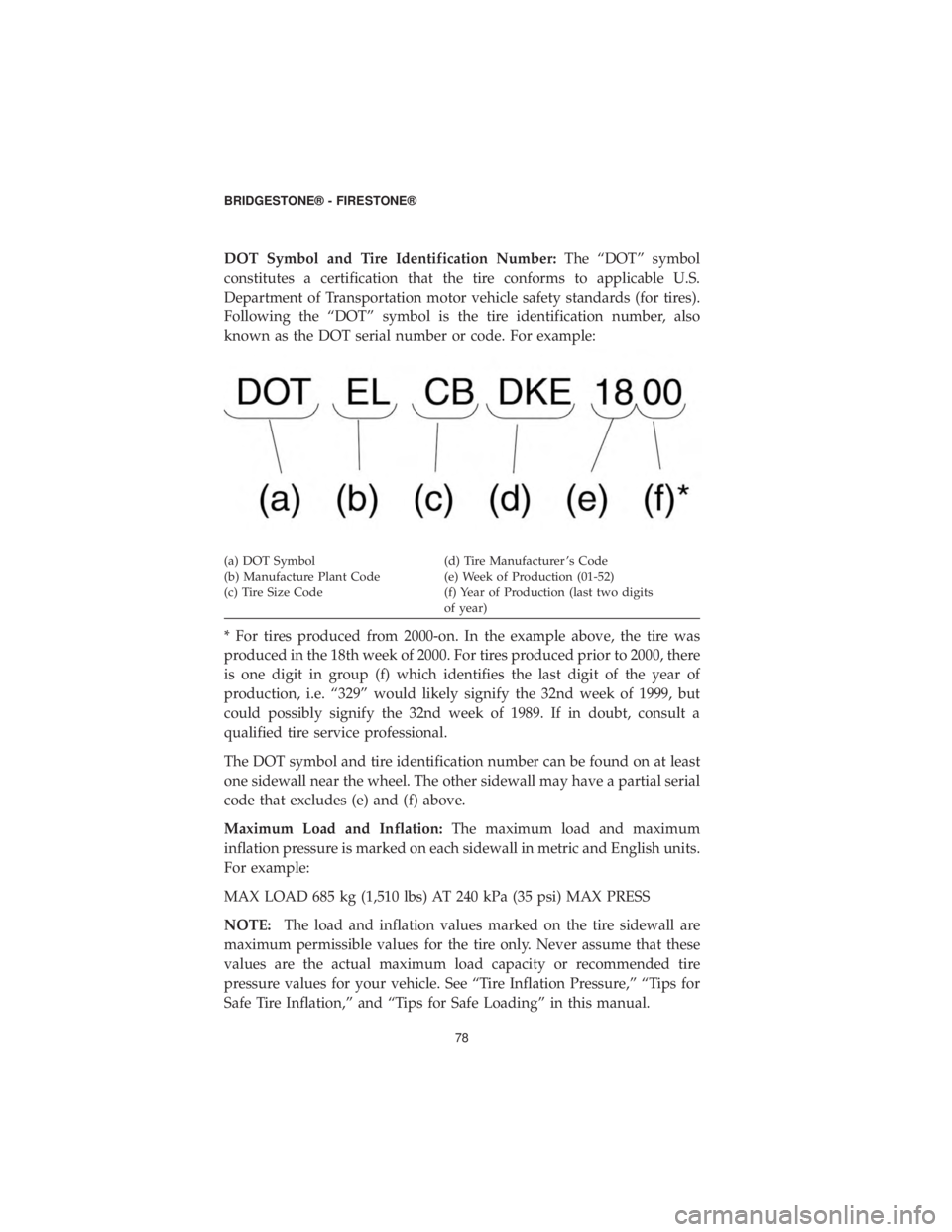
DOT Symbol and Tire Identification Number:The “DOT” symbol
constitutes a certification that the tire conforms to applicable U.S.
Department of Transportation motor vehicle safety standards (for tires).
Following the “DOT” symbol is the tire identification number, also
known as the DOT serial number or code. For example:
(a) DOT Symbol (d) Tire Manufacturer ’s Code
(b) Manufacture Plant Code (e) Week of Production (01-52)
(c) Tire Size Code (f) Year of Production (last two digits
of year)
* For tires produced from 2000-on. In the example above, the tire was
produced in the 18th week of 2000. For tires produced prior to 2000, there
is one digit in group (f) which identifies the last digit of the year of
production, i.e. “329” would likely signify the 32nd week of 1999, but
could possibly signify the 32nd week of 1989. If in doubt, consult a
qualified tire service professional.
The DOT symbol and tire identification number can be found on at least
one sidewall near the wheel. The other sidewall may have a partial serial
code that excludes (e) and (f) above.
Maximum Load and Inflation: The maximum load and maximum
inflation pressure is marked on each sidewall in metric and English units.
For example:
MAX LOAD 685 kg (1,510 lbs) AT 240 kPa (35 psi) MAX PRESS
NOTE: The load and inflation values marked on the tire sidewall are
maximum permissible values for the tire only. Never assume that these
values are the actual maximum load capacity or recommended tire
pressure values for your vehicle. See “Tire Inflation Pressure,” “Tips for
Safe Tire Inflation,” and “Tips for Safe Loading” in this manual.
BRIDGESTONE® - FIRESTONE®
78
Page 96 of 270
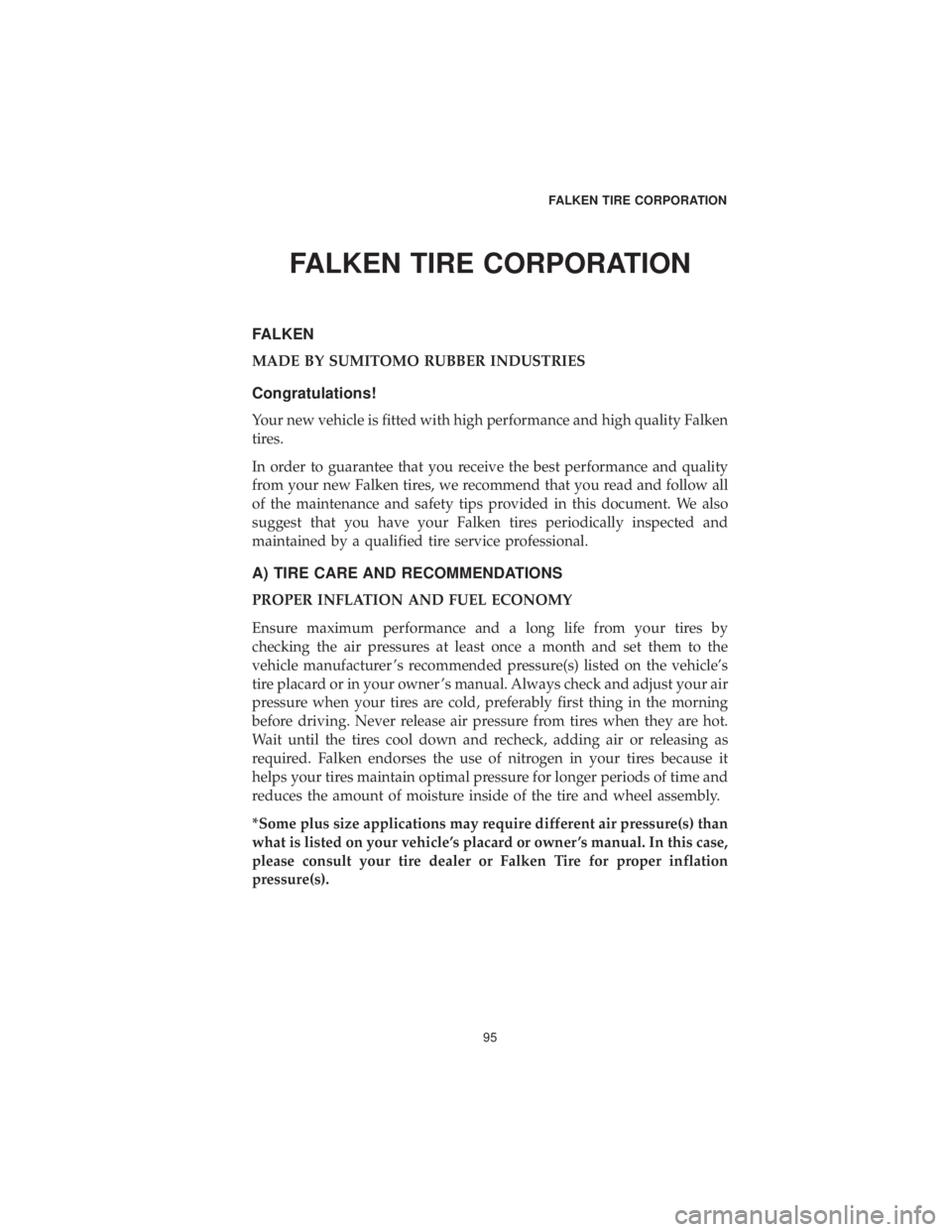
FALKEN TIRE CORPORATION
FALKEN
MADE BY SUMITOMO RUBBER INDUSTRIES
Congratulations!
Your new vehicle is fitted with high performance and high quality Falken
tires.
In order to guarantee that you receive the best performance and quality
from your new Falken tires, we recommend that you read and follow all
of the maintenance and safety tips provided in this document. We also
suggest that you have your Falken tires periodically inspected and
maintained by a qualified tire service professional.
A) TIRE CARE AND RECOMMENDATIONS
PROPER INFLATION AND FUEL ECONOMY
Ensure maximum performance and a long life from your tires by
checking the air pressures at least once a month and set them to the
vehicle manufacturer ’s recommended pressure(s) listed on the vehicle’s
tire placard or in your owner ’s manual. Always check and adjust your air
pressure when your tires are cold, preferably first thing in the morning
before driving. Never release air pressure from tires when they are hot.
Wait until the tires cool down and recheck, adding air or releasing as
required. Falken endorses the use of nitrogen in your tires because it
helps your tires maintain optimal pressure for longer periods of time and
reduces the amount of moisture inside of the tire and wheel assembly.
*Some plus size applications may require different air pressure(s) than
what is listed on your vehicle’s placard or owner ’s manual. In this case,
please consult your tire dealer or Falken Tire for proper inflation
pressure(s).
FALKEN TIRE CORPORATION
95
Page 100 of 270
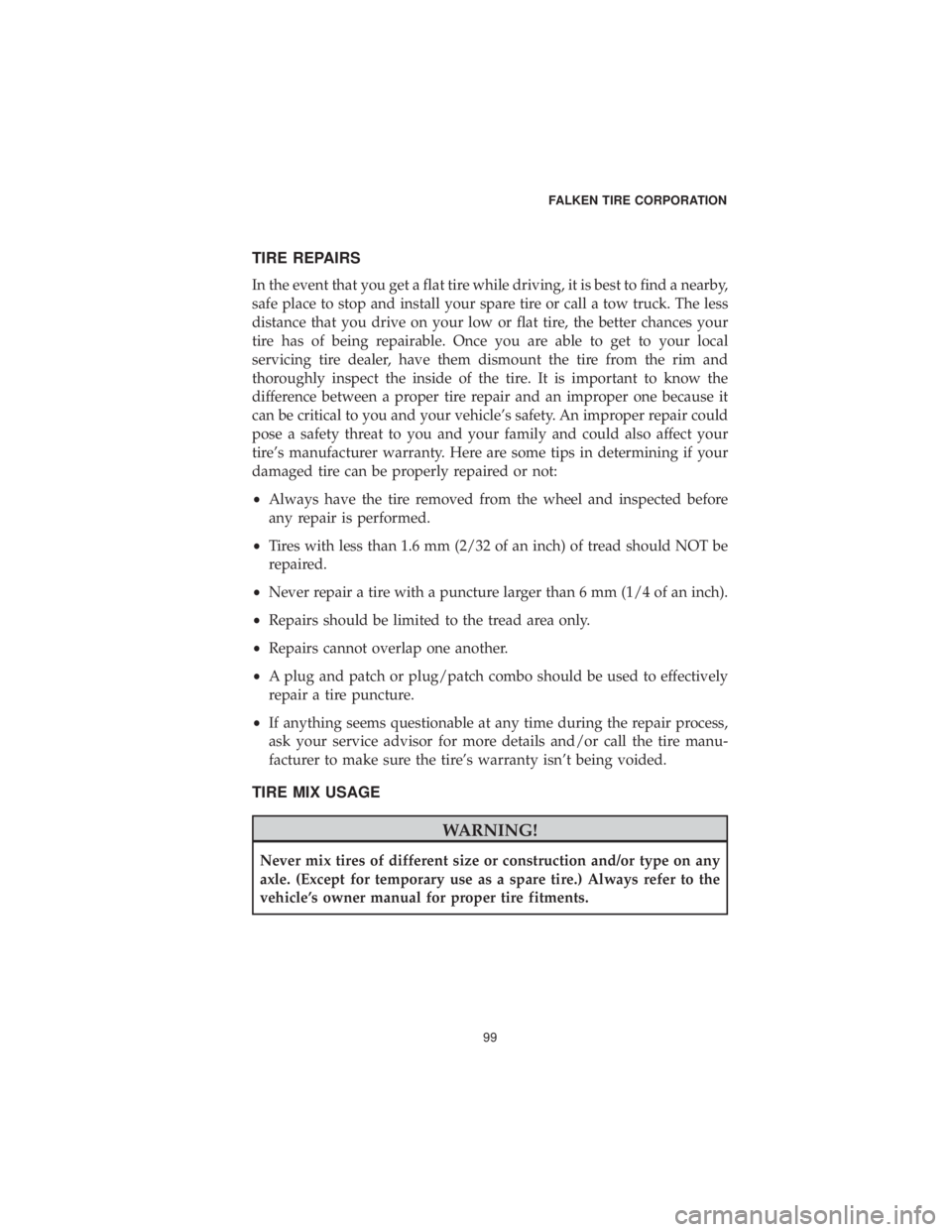
TIRE REPAIRS
In the event that you get a flat tire while driving, it is best to find a nearby,
safe place to stop and install your spare tire or call a tow truck. The less
distance that you drive on your low or flat tire, the better chances your
tire has of being repairable. Once you are able to get to your local
servicing tire dealer, have them dismount the tire from the rim and
thoroughly inspect the inside of the tire. It is important to know the
difference between a proper tire repair and an improper one because it
can be critical to you and your vehicle’s safety. An improper repair could
pose a safety threat to you and your family and could also affect your
tire’s manufacturer warranty. Here are some tips in determining if your
damaged tire can be properly repaired or not:
•Always have the tire removed from the wheel and inspected before
any repair is performed.
• Tires with less than 1.6 mm (2/32 of an inch) of tread should NOT be
repaired.
• Never repair a tire with a puncture larger than 6 mm (1/4 of an inch).
• Repairs should be limited to the tread area only.
• Repairs cannot overlap one another.
• A plug and patch or plug/patch combo should be used to effectively
repair a tire puncture.
• If anything seems questionable at any time during the repair process,
ask your service advisor for more details and/or call the tire manu-
facturer to make sure the tire’s warranty isn’t being voided.
TIRE MIX USAGE
WARNING!
Never mix tires of different size or construction and/or type on any
axle. (Except for temporary use as a spare tire.) Always refer to the
vehicle’s owner manual for proper tire fitments.
FALKEN TIRE CORPORATION
99
Page 129 of 270
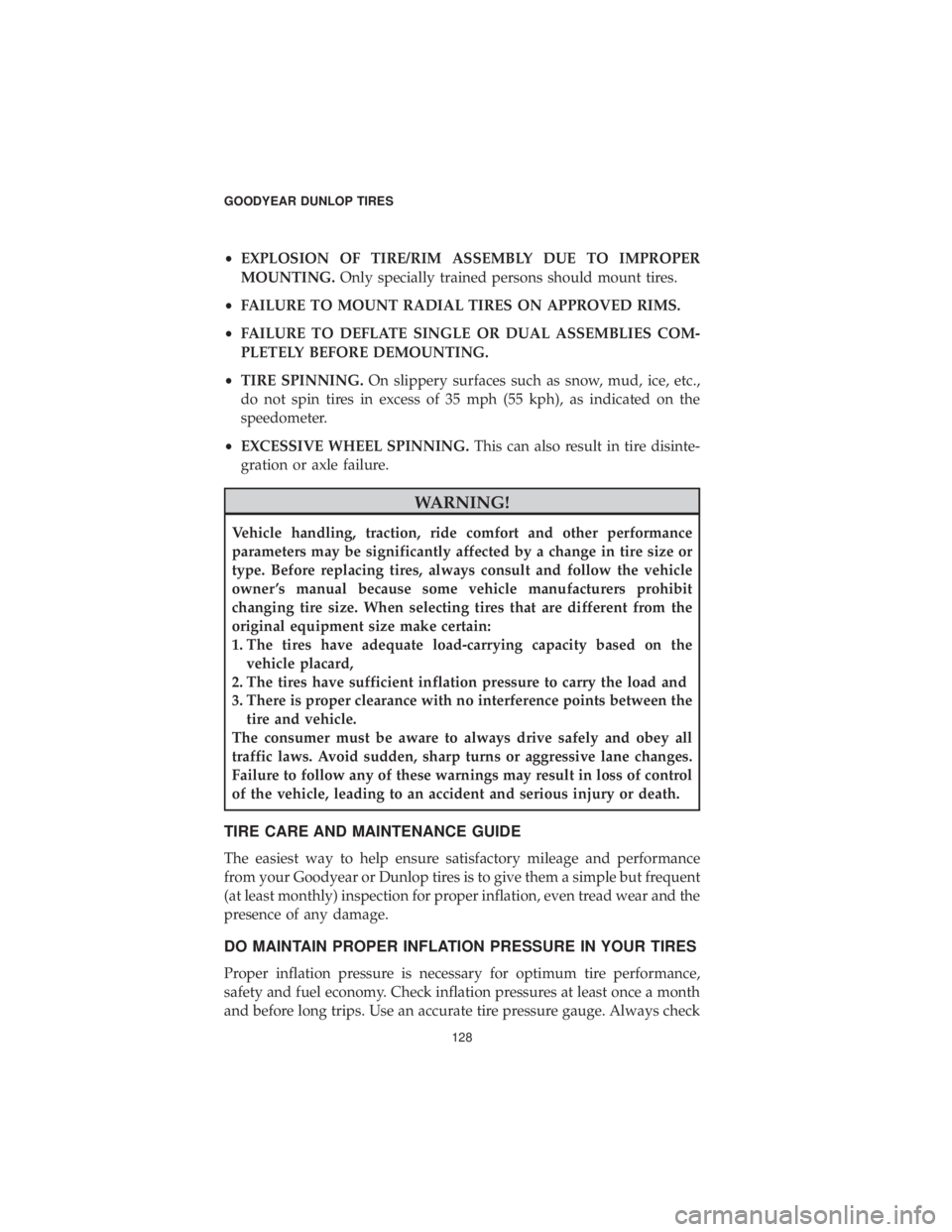
•EXPLOSION OF TIRE/RIM ASSEMBLY DUE TO IMPROPER
MOUNTING. Only specially trained persons should mount tires.
• FAILURE TO MOUNT RADIAL TIRES ON APPROVED RIMS.
• FAILURE TO DEFLATE SINGLE OR DUAL ASSEMBLIES COM-
PLETELY BEFORE DEMOUNTING.
• TIRE SPINNING. On slippery surfaces such as snow, mud, ice, etc.,
do not spin tires in excess of 35 mph (55 kph), as indicated on the
speedometer.
• EXCESSIVE WHEEL SPINNING. This can also result in tire disinte-
gration or axle failure.
WARNING!
Vehicle handling, traction, ride comfort and other performance
parameters may be significantly affected by a change in tire size or
type. Before replacing tires, always consult and follow the vehicle
owner ’s manual because some vehicle manufacturers prohibit
changing tire size. When selecting tires that are different from the
original equipment size make certain:
1. The tires have adequate load-carrying capacity based on the vehicle placard,
2. The tires have sufficient inflation pressure to carry the load and
3. There is proper clearance with no interference points between the tire and vehicle.
The consumer must be aware to always drive safely and obey all
traffic laws. Avoid sudden, sharp turns or aggressive lane changes.
Failure to follow any of these warnings may result in loss of control
of the vehicle, leading to an accident and serious injury or death.
TIRE CARE AND MAINTENANCE GUIDE
The easiest way to help ensure satisfactory mileage and performance
from your Goodyear or Dunlop tires is to give them a simple but frequent
(at least monthly) inspection for proper inflation, even tread wear and the
presence of any damage.
DO MAINTAIN PROPER INFLATION PRESSURE IN YOUR TIRES
Proper inflation pressure is necessary for optimum tire performance,
safety and fuel economy. Check inflation pressures at least once a month
and before long trips. Use an accurate tire pressure gauge. Always check
GOODYEAR DUNLOP TIRES
128
Page 134 of 270
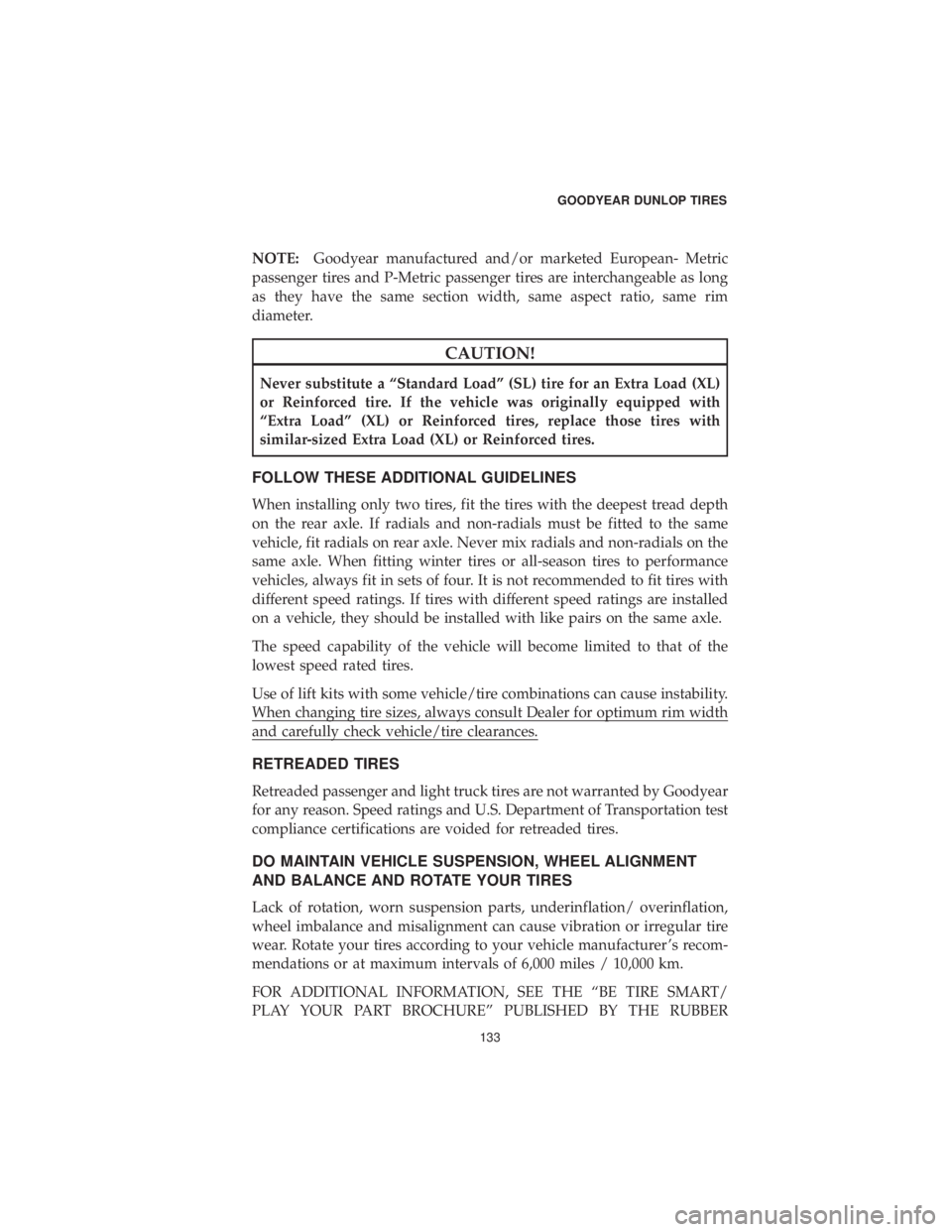
NOTE:Goodyear manufactured and/or marketed European- Metric
passenger tires and P-Metric passenger tires are interchangeable as long
as they have the same section width, same aspect ratio, same rim
diameter.
CAUTION!
Never substitute a “Standard Load” (SL) tire for an Extra Load (XL)
or Reinforced tire. If the vehicle was originally equipped with
“Extra Load” (XL) or Reinforced tires, replace those tires with
similar-sized Extra Load (XL) or Reinforced tires.
FOLLOW THESE ADDITIONAL GUIDELINES
When installing only two tires, fit the tires with the deepest tread depth
on the rear axle. If radials and non-radials must be fitted to the same
vehicle, fit radials on rear axle. Never mix radials and non-radials on the
same axle. When fitting winter tires or all-season tires to performance
vehicles, always fit in sets of four. It is not recommended to fit tires with
different speed ratings. If tires with different speed ratings are installed
on a vehicle, they should be installed with like pairs on the same axle.
The speed capability of the vehicle will become limited to that of the
lowest speed rated tires.
Use of lift kits with some vehicle/tire combinations can cause instability.
When changing tire sizes, always consult Dealer for optimum rim width
and carefully check vehicle/tire clearances.
RETREADED TIRES
Retreaded passenger and light truck tires are not warranted by Goodyear
for any reason. Speed ratings and U.S. Department of Transportation test
compliance certifications are voided for retreaded tires.
DO MAINTAIN VEHICLE SUSPENSION, WHEEL ALIGNMENT
AND BALANCE AND ROTATE YOUR TIRES
Lack of rotation, worn suspension parts, underinflation/ overinflation,
wheel imbalance and misalignment can cause vibration or irregular tire
wear. Rotate your tires according to your vehicle manufacturer ’s recom-
mendations or at maximum intervals of 6,000 miles / 10,000 km.
FOR ADDITIONAL INFORMATION, SEE THE “BE TIRE SMART/
PLAY YOUR PART BROCHURE” PUBLISHED BY THE RUBBER
GOODYEAR DUNLOP TIRES
133
Page 162 of 270
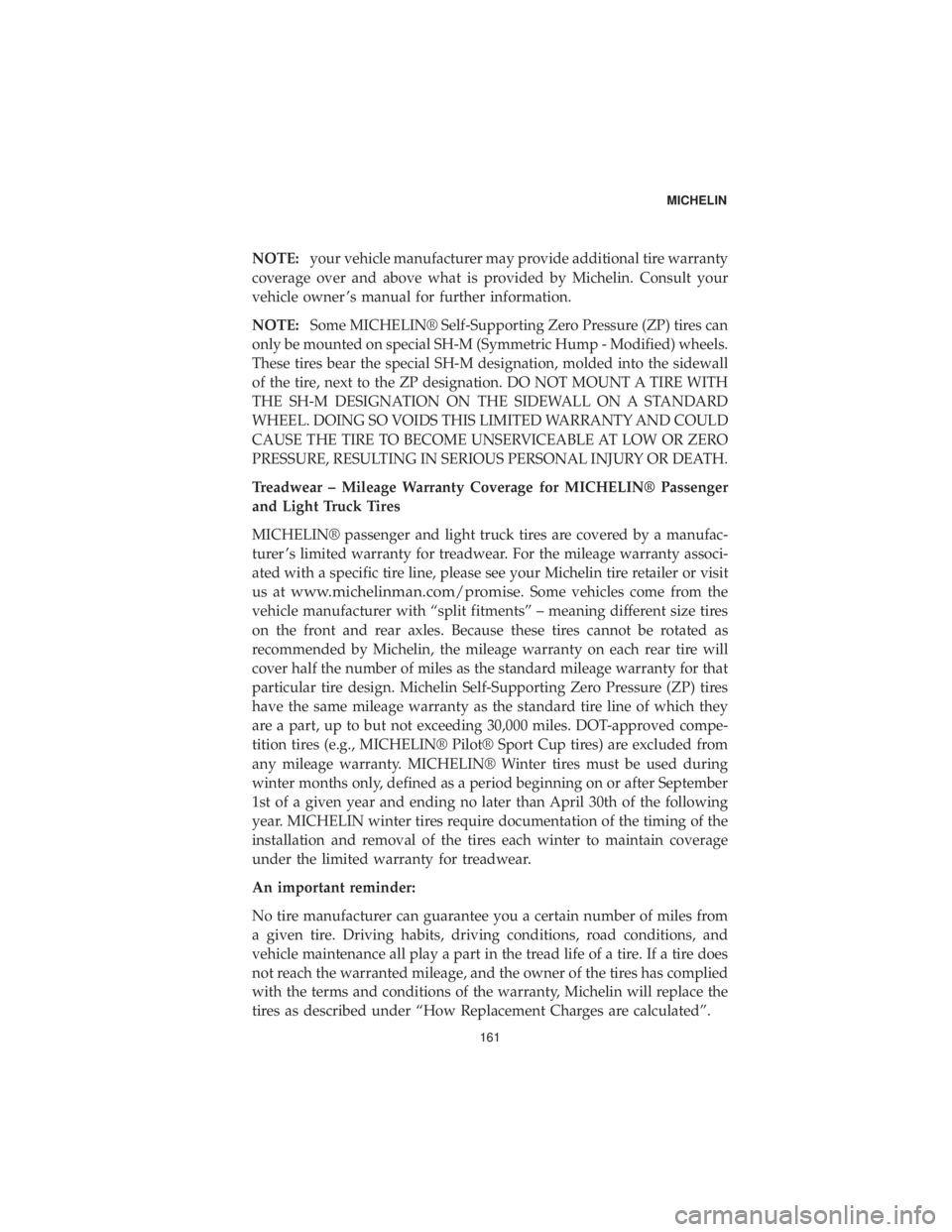
NOTE:your vehicle manufacturer may provide additional tire warranty
coverage over and above what is provided by Michelin. Consult your
vehicle owner ’s manual for further information.
NOTE: Some MICHELIN® Self-Supporting Zero Pressure (ZP) tires can
only be mounted on special SH-M (Symmetric Hump - Modified) wheels.
These tires bear the special SH-M designation, molded into the sidewall
of the tire, next to the ZP designation. DO NOT MOUNT A TIRE WITH
THE SH-M DESIGNATION ON THE SIDEWALL ON A STANDARD
WHEEL. DOING SO VOIDS THIS LIMITED WARRANTY AND COULD
CAUSE THE TIRE TO BECOME UNSERVICEABLE AT LOW OR ZERO
PRESSURE, RESULTING IN SERIOUS PERSONAL INJURY OR DEATH.
Treadwear – Mileage Warranty Coverage for MICHELIN® Passenger
and Light Truck Tires
MICHELIN® passenger and light truck tires are covered by a manufac-
turer ’s limited warranty for treadwear. For the mileage warranty associ-
ated with a specific tire line, please see your Michelin tire retailer or visit
us at
www.michelinman.com/promise. Some vehicles come from the
vehicle manufacturer with “split fitments” – meaning different size tires
on the front and rear axles. Because these tires cannot be rotated as
recommended by Michelin, the mileage warranty on each rear tire will
cover half the number of miles as the standard mileage warranty for that
particular tire design. Michelin Self-Supporting Zero Pressure (ZP) tires
have the same mileage warranty as the standard tire line of which they
are a part, up to but not exceeding 30,000 miles. DOT-approved compe-
tition tires (e.g., MICHELIN® Pilot® Sport Cup tires) are excluded from
any mileage warranty. MICHELIN® Winter tires must be used during
winter months only, defined as a period beginning on or after September
1st of a given year and ending no later than April 30th of the following
year. MICHELIN winter tires require documentation of the timing of the
installation and removal of the tires each winter to maintain coverage
under the limited warranty for treadwear.
An important reminder:
No tire manufacturer can guarantee you a certain number of miles from
a given tire. Driving habits, driving conditions, road conditions, and
vehicle maintenance all play a part in the tread life of a tire. If a tire does
not reach the warranted mileage, and the owner of the tires has complied
with the terms and conditions of the warranty, Michelin will replace the
tires as described under “How Replacement Charges are calculated”.
MICHELIN
161
Page 172 of 270
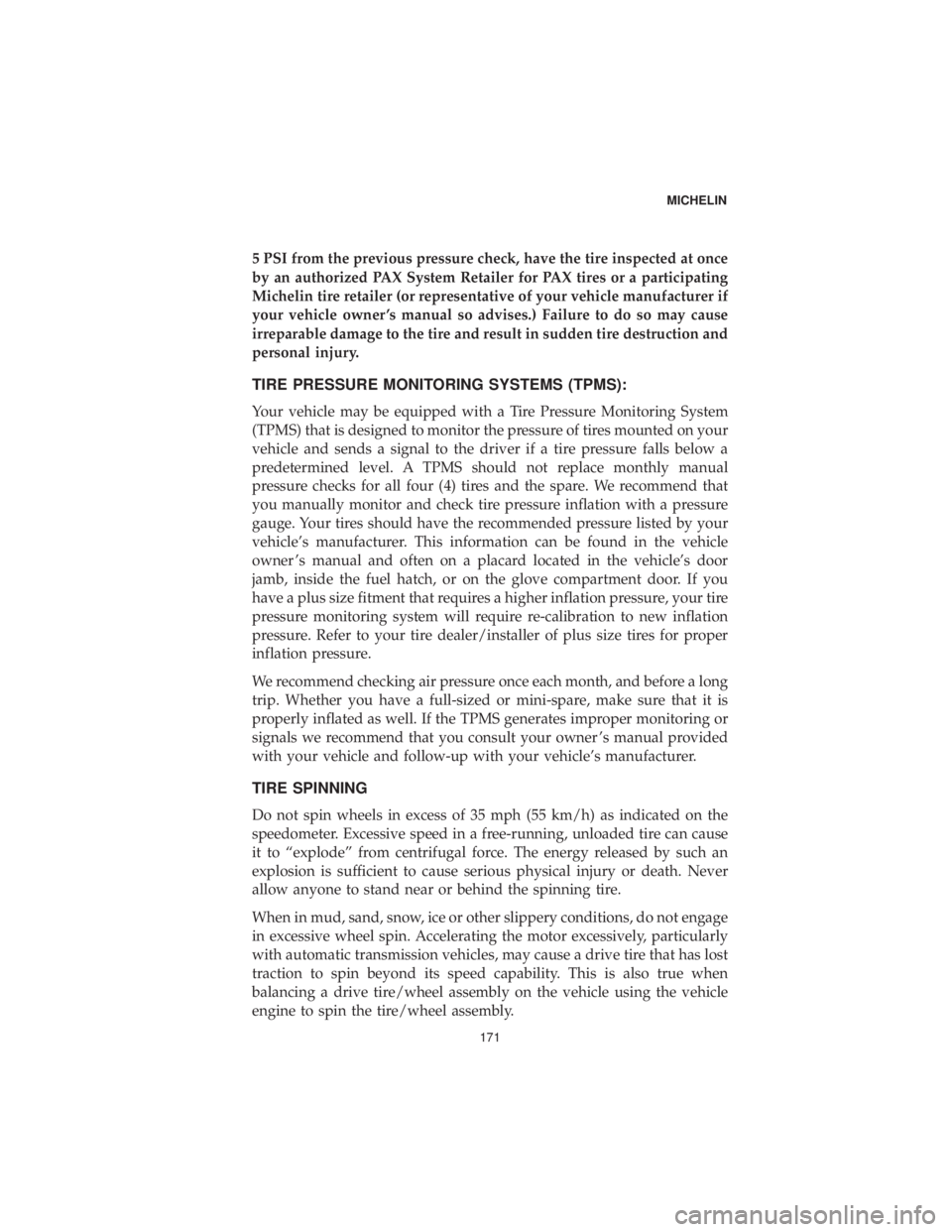
5 PSI from the previous pressure check, have the tire inspected at once
by an authorized PAX System Retailer for PAX tires or a participating
Michelin tire retailer (or representative of your vehicle manufacturer if
your vehicle owner ’s manual so advises.) Failure to do so may cause
irreparable damage to the tire and result in sudden tire destruction and
personal injury.
TIRE PRESSURE MONITORING SYSTEMS (TPMS):
Your vehicle may be equipped with a Tire Pressure Monitoring System
(TPMS) that is designed to monitor the pressure of tires mounted on your
vehicle and sends a signal to the driver if a tire pressure falls below a
predetermined level. A TPMS should not replace monthly manual
pressure checks for all four (4) tires and the spare. We recommend that
you manually monitor and check tire pressure inflation with a pressure
gauge. Your tires should have the recommended pressure listed by your
vehicle’s manufacturer. This information can be found in the vehicle
owner ’s manual and often on a placard located in the vehicle’s door
jamb, inside the fuel hatch, or on the glove compartment door. If you
have a plus size fitment that requires a higher inflation pressure, your tire
pressure monitoring system will require re-calibration to new inflation
pressure. Refer to your tire dealer/installer of plus size tires for proper
inflation pressure.
We recommend checking air pressure once each month, and before a long
trip. Whether you have a full-sized or mini-spare, make sure that it is
properly inflated as well. If the TPMS generates improper monitoring or
signals we recommend that you consult your owner ’s manual provided
with your vehicle and follow-up with your vehicle’s manufacturer.
TIRE SPINNING
Do not spin wheels in excess of 35 mph (55 km/h) as indicated on the
speedometer. Excessive speed in a free-running, unloaded tire can cause
it to “explode” from centrifugal force. The energy released by such an
explosion is sufficient to cause serious physical injury or death. Never
allow anyone to stand near or behind the spinning tire.
When in mud, sand, snow, ice or other slippery conditions, do not engage
in excessive wheel spin. Accelerating the motor excessively, particularly
with automatic transmission vehicles, may cause a drive tire that has lost
traction to spin beyond its speed capability. This is also true when
balancing a drive tire/wheel assembly on the vehicle using the vehicle
engine to spin the tire/wheel assembly.
MICHELIN
171
Page 177 of 270
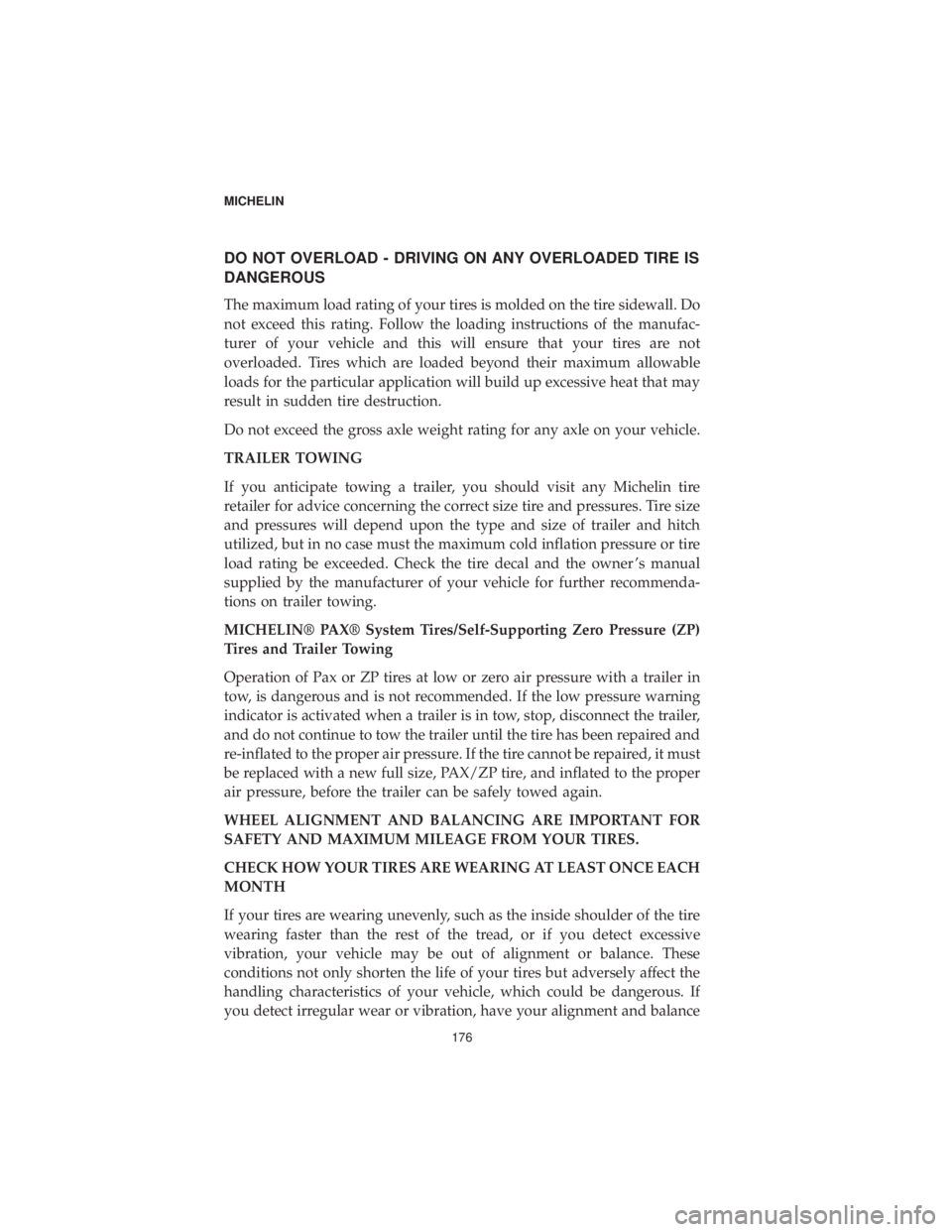
DO NOT OVERLOAD - DRIVING ON ANY OVERLOADED TIRE IS
DANGEROUS
The maximum load rating of your tires is molded on the tire sidewall. Do
not exceed this rating. Follow the loading instructions of the manufac-
turer of your vehicle and this will ensure that your tires are not
overloaded. Tires which are loaded beyond their maximum allowable
loads for the particular application will build up excessive heat that may
result in sudden tire destruction.
Do not exceed the gross axle weight rating for any axle on your vehicle.
TRAILER TOWING
If you anticipate towing a trailer, you should visit any Michelin tire
retailer for advice concerning the correct size tire and pressures. Tire size
and pressures will depend upon the type and size of trailer and hitch
utilized, but in no case must the maximum cold inflation pressure or tire
load rating be exceeded. Check the tire decal and the owner ’s manual
supplied by the manufacturer of your vehicle for further recommenda-
tions on trailer towing.
MICHELIN® PAX® System Tires/Self-Supporting Zero Pressure (ZP)
Tires and Trailer Towing
Operation of Pax or ZP tires at low or zero air pressure with a trailer in
tow, is dangerous and is not recommended. If the low pressure warning
indicator is activated when a trailer is in tow, stop, disconnect the trailer,
and do not continue to tow the trailer until the tire has been repaired and
re-inflated to the proper air pressure. If the tire cannot be repaired, it must
be replaced with a new full size, PAX/ZP tire, and inflated to the proper
air pressure, before the trailer can be safely towed again.
WHEEL ALIGNMENT AND BALANCING ARE IMPORTANT FOR
SAFETY AND MAXIMUM MILEAGE FROM YOUR TIRES.
CHECK HOW YOUR TIRES ARE WEARING AT LEAST ONCE EACH
MONTH
If your tires are wearing unevenly, such as the inside shoulder of the tire
wearing faster than the rest of the tread, or if you detect excessive
vibration, your vehicle may be out of alignment or balance. These
conditions not only shorten the life of your tires but adversely affect the
handling characteristics of your vehicle, which could be dangerous. If
you detect irregular wear or vibration, have your alignment and balance
MICHELIN176